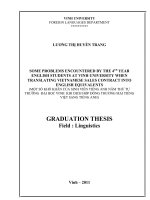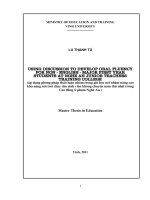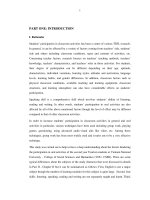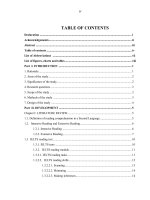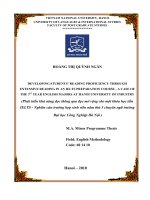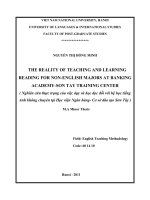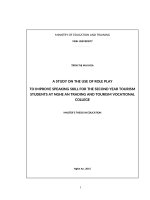An investigation into listening comprehension problems of the second year English students at Nghe An junior Teachers Training College = Nghiên cứu những khó kh
Bạn đang xem bản rút gọn của tài liệu. Xem và tải ngay bản đầy đủ của tài liệu tại đây (643.67 KB, 52 trang )
1
VIETNAM NATIONAL UNIVERSITY, HANOI
UNIVERSITY OF LANGUAGES AND INTERNATIONAL STUDIES
DEPARTMENT OF POST GRADUATE STUDIES
*********************
TRẦN THỊ THANH HOA
AN INVESTIGATION INTO LISTENING COMPREHENSION
PROBLEMS OF THE SECOND YEAR ENGLISH STUDENTS AT NGHE
AN JUNIOR TEACHERS TRAINING COLLEGE
(Nghiên cứu những khó khăn trong việc học kỹ năng nghe hiểu của sinh viên
chuyên Anh năm thứ hai ở trường CĐSP Nghệ An.)
M.A Minor Program Thesis
Field: English Teaching Methodology
Code: 601410
Hanoi, 2010
2
VIETNAM NATIONAL UNIVERSITY, HANOI
UNIVERSITY OF LANGUAGES AND INTERNATIONAL STUDIES
DEPARTMENT OF POST GRADUATE STUDIES
*********************
TRẦN THỊ THANH HOA
AN INVESTIGATION INTO LISTENING COMPREHENSION
PROBLEMS OF THE SECOND YEAR ENGLISH STUDENTS AT NGHE
AN JUNIOR TEACHERS TRAINING COLLEGE
(Nghiên cứu những khó khăn trong việc học kỹ năng nghe hiểu của sinh viên
chuyên Anh năm thứ hai ở trường CĐSP Nghệ An.)
M.A Minor Program Thesis
Field: Methodology
Code: 601410
Supervisor: Đinh Hải Yến, M.Ed
Hanoi, 2010
6
LIST OF TABLES
Table 1 Learners‟ perceptions of strategies of listening comprehension
Table 2 learners‟ perception of listening problems related to the listening
text
Table 3 Learners‟ perception of listening problems related to tasks and
activities
Table 4 Learners‟ perceptions of listening problems related to the listener
Table 5 Learners‟ perceptions of teacher‟s teaching methods
Table 6 Teachers‟ perceptions of teaching methods
Table 7 Teachers‟ perceptions of learners‟ strategy uses
Table 8 The expectations of the students towards teachers of listening skill
Page
21
23
25
27
28
30
32
34
7
LIST OF ABBREVIATIONS
JTTC: Junior teachers training college
8
TABLE OF CONTENT
Declaration
Acknowledgements
Abstract
List of tables
List of abbreviations
PART A: INTRODUCTION ………………………………………………………
1. Rationale …………………………………………………………………………
2. Aims of the study …………………………………………………………………
3. Scope of the study …………………………………………………………………
4. Significance of the study …………………………………………………………
5. Method of the study ……………………………………………………………….
6. Design of the study ………………………………………………………………
PART B: DEVELOPMENT ……………………………………………
Chapter one: Literature review ……………………………………………………
1.1 The nature of listening comprehension …………………………………………
1.1.1 The concept of listening comprehension …………………………………
1.1.2 The listening comprehension process …………………………………….
1.2 Potential problems in learning listening comprehension ………………………
1.3 Strategies of listening comprehension …………………………………………
1.4 Three stages of the listening session …………………………………………….
1.4.1 Pre-listening stage ………………………………………………………
1.4.2 While-listening stage ……………………………………………………
1.4.3 Post-listening stage ……………………………………………………….
1.5 Related studies of listening comprehension problems …………………………
1.6 Summary ………………………………………………………………………
1
1
2
2
2
3
3
5
5
5
5
6
8
10
12
12
13
13
14
15
9
Chapter two: Methodology …………………………………………………………
2.1 Participants ……………………………………………………………………….
2.1.1 Students …………………………………………………………………….
2.1.2 Teachers ……………………………………………………………………
2.2 Setting of the study ………………………………………………………………
2.3 Research methods ………………………………………………………………
2.3.1 Research questions …………………………………………………………
2.3.2 Data collection instrument …………………………………………………
2.3.3 Data analysis method ………………………………………………………
2.4 Summary …………………………………………………………………………
Chapter three: Data results, discussions of major findings and
recommendations ……………………………………………………………………
3.1 Sources of listening comprehension problems experienced by students at N.A
JTTC ………………………………………………………………………………….
3.1.1 Learners‟ perceptions of strategies of listening comprehension …………
3.1.2 Learners‟ perceptions of listening problems related to the listening text ….
3.1.3 Learners‟ perceptions of listening problems related to task and activities…
3.1.4 Learners‟ perceptions of listening problems related to listener ……………
3.1.5 Learners‟ perceptions of teacher‟s teaching methods ……………………
3.2 Sources of listening comprehension problems reflected by teachers ……………
3.2.1 Teachers‟ perceptions of teaching methods ………………………………
3.2.2 Teachers‟ perceptions of learners‟ strategy uses …………………………
3.3 The expectations of the students towards teachers of listening skill …………….
3.4 Recommendations for improvement of the efficiency of teaching and learning of
2
nd
year English students at Nghe An JTTC ………………………………………….
3.4.1 Recommendations for teachers of English …………………………………
3.4.1.1 Adapting and improving listening materials …………………………
3.4.1.2 Improving teachers‟ classroom techniques …………………………
3.4.2 Recommendations for students …………………………………………….
3.4.2.1 Improving English proficiency ………………………………………
16
16
16
16
17
18
18
18
20
20
21
21
21
22
25
27
28
29
29
31
33
34
34
34
35
37
37
10
3.4.2.2 Improving listening strategies ………………………………………
3.5 Summary …………………………………………………………………………
PART C: CONCLUSIONS ………………………………………………….
1. Summary of the study …………………………………………………………….
2. Conclusions ……………………………………………………………………….
3. Limitations and suggestions for further study ……………………………………
REFERENCES …………………………………………………………………
APPENDICES
37
38
40
40
40
41
43
11
PART A: INTRODUCTION
1. RATIONALE
English language teaching profession has changed tremendously over the last few
decades in the light of Communicative Language Teaching approach. Training
learners to be able to use English for communicative purposes has become the goal. In
order to use English effectively, learners need to develop communicative competence.
Accordingly, they should be helped to develop four skills: listening, speaking, reading
and writing. However, among the four given skills, it is now generally recognized that
listening plays a key role in facilitating language learning. Rost (1994, as cited in
Nunan & Miller, 1995) confirmed that listening is vital in language classrooms
because it provides input for learners. Without understanding inputs at the right level,
any kind of learning simply cannot occur. Listening, therefore, is essential not only as
a receptive skill but also to the development of spoken language proficiency.
In many colleges and universities in Vietnam, listening has played a very important
part in learning a foreign language and it is recognized as the principal objective of
language courses. However, the teaching of listening skills is still the weak link in the
language teaching process.
At Nghe An Junior Teachers‟ Training College, listening is treated equally as other
skills in terms of time allocation. In fact, it has not drawn much attention of both
teachers and learners, they are generally less aware of its importance. In classrooms,
teachers seem to test, not to teach listening. Meanwhile, students seem to learn
listening, not listening comprehension. Thus, students cannot listen effectively. If they
are asked to rank the four macro language skills: Speaking, reading, writing and
listening in order of difficulty, listening skill will probably be one of those which are
put at the top of the list.
12
From her observation and experience in working as an English teacher for nearly 10
years, the researcher has noticed that her students have lots of difficulties in listening
comprehension. This becomes a strong inspiration for her to have an investigation into
their listening comprehension problems through which she can identify kinds of
listening problem and factors causing their difficulties. This would help the researcher
to work out possible solutions to help improve the effectiveness of teaching and
learning listening comprehension at her college.
2. AIMS OF THE STUDY
The purpose of the study is to investigate the listening comprehension problems of the
2
nd
year English students at Nghe An JTTC. Therefore, the specific aims are:
1. To find out kinds of listening comprehension problems encountered by 2
nd
English
students at Nghe An JTTC
2. To find out factors causing their difficulties in listening comprehension
3. To provide some suggestions on strategies to help students overcome
3. SCOPE OF THE STUDY
The minor thesis is conducted at Nghe An JTTC in order to perceive difficulties in
learning listening comprehension of the 2
nd
year English students. The study focuses
on describing the problems and factors causing the given difficulties related to
strategies of listening comprehension, the listening text, tasks and activities, listener,
and teachers‟ methodology.
4. SIGNIFICANCE OF THE STYDY
This study points out the listening comprehension problems encountered by 2
nd
English students at Nghe An JTTC. More importantly, it is a further contribution to
the investigation of foreign language listening comprehension problems in actual
language classroom practice.
Hopefully, the findings and recommendations of this study will be of some help to the
improvement of the teaching and learning listening comprehension of English of
Vietnamese students in general and of Nghe An college students in particular. The
study also gives some guidelines for teachers to help their students overcome their
13
listening comprehension problems. The results of this study may also be useful for
those who are interested in this field.
5. METHOD OF THE STUDY
To fulfill the above aims, the study was carried out with quantitative method of data
collection:
1. A questionnaire designed for students consists of two parts.
Part one aims at obtaining demographic data about the participants such as
name, age, gender and the number of years they have been studying English
and listening skill as well.
Part two with focus on listening comprehension problems formulated from
learners‟ perceptions of listening comprehension problems is based on the
model advocated by Ali S. Hasan (Hasan, 2000) to find out kinds of their
listening comprehension problems and factors affecting their difficulties.
2. Another questionnaire was delivered to the teachers. It is aimed at obtaining
information concerning their perceptions of listening comprehension problems for
their 2
nd
year students.
6. DESIGN OF THE STUDY
This study is divided into three parts.
Part A, INTRODUTION, presents reasons for choosing the topic, aims, scope,
significance, methods as well as the design of the study.
Part B, DEVELOPMENT, has three following chapters:
Chapter one is the Literature Review which deals with theories on factors involving
listening comprehension and listening comprehension problems.
In chapter two, Methodology, the current situation of teaching and learning listening
at N.A JTTC is investigated. The research methods which cover research questions,
the participants, data collection instruments are presented in this chapter.
14
Chapter three presents the data results, analysis and discussion of major findings of
listening comprehension problems, factors contributing to their difficulties and
provides some suggestions on strategies to help students overcome their difficulties.
Part C, CONCLUSION, summarizes what are addressed in the study, particularly the
major findings and recommendations. The limitations of the study and some
suggestions for further study are also included in this part.
15
PART B: DEVELOPMENT
Chapter one: LITERATURE REVIEW
1.1 The Nature of Listening Comprehension
1.1.1 The concept of listening comprehension
There have been a large number of definitions of listening comprehension which present
different views of scholars towards the concept.
Traditional views considered listening as a passive language skill alongside with reading
skill. Listeners were regarded as a tape-recorder, took in and stored aural messages in
much the same way as the tape-recorder. They just hear what they are to listen without
paying sufficient attention to the discourse such as background knowledge of the speakers
as well as their intentions, attitudes, implications and other shades of meaning etc.
Nowadays, there exist different views about listening comprehension.
Anderson and Lynch (1988, as cited in Fang, 2008, p. 21), considered the listener as an
active model builder. This kind of listener could combine the new information with his
previous knowledge and experience to reach full comprehension of what had been heard.
This view emphasized the active interpretation and integration of incoming information
with prior knowledge and experience.
According to Buck (2001), listening comprehension is an active process of constructing
meaning and this is done by “applying knowledge to the incoming sounds” (p.31) in
which “number of different types of knowledge are involved: both linguistic knowledge
and non-linguistic knowledge” (p.31).
O‟Malley and Chamot (1989, p. 420) made a conclusion that
Listening comprehension is an active and conscious process in which the listener
constructs meaning by using cues from contextual information and existing
knowledge, while relying upon multiple strategic resources to fulfill the task
requirement.
16
Vandergrift (1999, p.168) emphasized that
Listening is a complex, active process in which the listener must discriminate
between sounds, understand vocabulary and grammatical structures, interpret
stress and intonation, retain what was gathered in all of the above, and interpret it
within the immediate as well as the larger socio-cultural context of the utterance.
In short, listening is not a passive but active and conscious process in which learners
construct and convey meaning by using not only the linguistic cues but their non-
linguistic knowledge as well. Linguistic knowledge is of different types, but among the
most important are phonology, lexis, syntax, semantics and discourse structure. The non-
linguistic knowledge used in comprehension is knowledge about the topic, the context,
and general knowledge about the world and how it works.
1.1.2 The listening comprehension process
Listening comprehension is regarded theoretically as an active process in which
individuals concentrate on selected aspects of aural input, form meaning from passages,
and associate what they hear with existing knowledge.
Rost (2002, as cited in Vandergrift, http:// www.llas.ac.uk/resourses/gpg/67) defines
listening, in its broad sense, as a process of receiving what the speaker actually says
(receptive orientation), constructing and representing meaning (constructive orientation),
negotiating meaning with the speaker and responding (collaborative orientation) and
creating meaning through involvement, imagination and empathy (transformative
orientation).
Moreover, it is agreed that the comprehension process is constructed based on the two
principal sources of information which Widdowson (1983) refers to as (1) systematic or
linguistic knowledge (knowledge of phonological, syntactic, and semantic components of
the language system) and (2) schematic or non-linguistic information. There has been
17
much debate about this knowledge though, the two most important views are bottom-up
view and top-down view.
Bottom-up view considers listening comprehension as a process in which listeners make
sense of what they hear by focusing on different parts such as vocabulary, grammar or
functional phrases, sounds, etc. Schemata are hierarchically formed, from the most
specific at the bottom to the most general at the top. It acknowledges that listening is a
process of decoding the sounds, from the smallest meaningful units (phonemes) to
complete texts. This process is closely associated with the listener‟s linguistic knowledge.
However, bottom-up processing has its weak points. Understanding a text is an
interactive process between the listener‟s previous knowledge and the text. Efficient
comprehension that associates the textual material with listener‟s brain does not only
depend on one‟s linguistic knowledge.
Top-down view, on the other hand, starts with background knowledge in comprehending
the meaning of a message. This knowledge can be content schema (general knowledge
based on life experience and previous learning) or textual schema (knowledge of
language and content used in a particular situation). While listening, the listener actively
constructs (or reconstructs) the original meaning of the speaker employing new input as
clues to understand what he/ she hears. However, if the incoming information the listener
hears is unfamiliar to him, it cannot evoke his schemata and he can only depend heavily
on his linguistic knowledge in listening comprehension. Besides, although the listener can
trigger a schema, he might not have the suitable schema expected by the speaker. Thus,
only relying on top-down processing may result in the failure of comprehension.
The two views above have certain disadvantages. Bottom-up view focuses on linguistic
knowledge whereas top-down bases on background knowledge. While listening,
accordingly, if listeners depend heavily on one of two, they will fail to understand the
spoken text. It is now generally accepted that both top-down and bottom-up processes
should be combined to enhance listening comprehension. These two processes intersect to
develop an interactive process. The process employing background knowledge
information, textual information and linguistic information make comprehension and
18
interpretation become easy for listeners. When the content of the material is familiar to
the listener, he will employ his background knowledge at the same time to make
predictions of what the speakers are going to say or to overcome barriers of unfamiliar
words. As opposed to this, if the listener is unfamiliar with the content of the listening
text, he can only depend on his linguistic knowledge, especially the lexical and
syntactical knowledge to make sense of the information.
In short, it is generally agreed that interactive process is the one that listeners should
employ to enhance listening comprehension. In this process, the listeners constantly
shuttle between bottom-up and top-down processes. Successful listening requires skill in
both top-down and bottom-up processing
1.2 Potential problems in learning listening comprehension
In the eyes of many learners of English, listening is usually regarded as the most difficult
skill. However, they have difficulties with different aspects.
According to Underwood (1989), there are seven problems which learners often
encounter in learning listening. Firstly, they cannot control the speed at which speakers
speak. Secondly, the listeners are not able to get things repeated. Another difficulty is
learners‟ limited vocabulary. The next, they are not able to recognize the „signals‟ by
which a speaker can indicate that he/she is moving from one point to another, or giving
an example, or repeating a point, or whatever. Underwood also indicates that listener may
have problems of interpretation. Students who are unfamiliar with the context may have
considerable difficulty in interpreting the words even if they can understand their
„surface‟ meaning. Especially, this can even occur when the speaker and listener are from
the same background and use the same language. Besides, inability to concentrate is a
major problem to the listeners, because even the shortest break in attention can seriously
impair comprehension. The last problem is learners‟ established learning habits due to the
fact that their teachers aims to teach them to understand everything in the English lesson.
Consequently, students are worried if they fail to understand a particular word or phrase
19
when they are listening. Underwood sees these problems as being related to learners‟
different background such as their culture and education.
Flowerdew and Miller (1996, as cited in Hasan, 2000, p. 139) found that students‟
problems in listening to academic lectures were speed of delivery, new terminology and
concepts, difficulties in concentrating, and problems related to physical environment.
Lee Chang Ngee (1985) identifies some problems which listeners often face including the
speed of the speaker and the language he uses; students‟ unfamiliarity with the sounds,
stress, intonation and rhythm of natural spoken English; different varieties or accents;
false starts, hesitation, repetitions and incomplete sentences. Besides, he also points out
that boredom, fatigue or distraction outside the classroom may affect the concentration of
the listeners.
Goh (2000) attributes ten listening comprehension problems in relation to three cognitive
processing phases – perceptions, parsing, and utilization. First, in the perception stage,
learner reported most difficult ones are: „do not recognize words they know‟, „neglect the
next part when thinking about meaning‟, „cannot chunk streams of speech‟, „miss the
beginning of texts‟, and „concentrate too hard or unable to concentrate‟. Second, in the
parsing stage, listeners complained of problems such as „quickly forget what is heard‟,
„unable to form a mental representation from words heard‟, and „do not understand
subsequent parts of input because of earlier problems‟. Third, in the utilization stage,
„understand the words but not the intended message‟ and „confused about the key ideas in
the message‟ were often mentioned (Goh, 2000). These reported difficulties partially
reflect Underwood‟s (1989) views on second language listening problems.
Yagang (1994) attributes the difficulty of listening comprehension to four sources: The
message, the speakers, the listeners and the physical setting.
As a whole, there are four main factors that contribute to the difficulty of listening
comprehension: speaker factors, the listener factors, the content of the listening, and the
physical environment. Theoretical explanations of listening comprehension presented
20
above provide clues about the problems which learners face when they listen to spoken
text. These insights can not, however, account for exhaustive explanation of these
problems. As Nunan (1991, p.38) states “theories, ideas, and research are as good as
teachers and textbook writers make them. Interesting and unexpected things happen in the
classroom, and in the final analysis, principles and ideas need to be tested in practice”
1.3 Strategies of listening comprehension
Listening strategies are techniques or activities that contribute directly to the
comprehension and recall of listening input. Listening strategies can be classified by how
the listener processes the input.
Top-down strategies are listener based ones in which the listener taps into background
knowledge of the topic, the situation or context, the type of the text, and the language.
This background knowledge activates a set of expectations that help the listener to
interpret what is heard and anticipate what will come next.
Top-down strategies include:
- Listening for main ideas
- Predicting
- Drawing inferences
- Summarizing
Bottom-up strategies are text based ones in which the listeners are trying to make sense of
what they hear by focusing on the language in the message, that is, the combination of
sounds, words, and grammar that creates meaning.
Bottom-up strategies include:
- Listening for specific details
- Recognizing cognates
- Recognizing word-order patterns
Listening comprehension tends to be an interactive, interpretive process in which listeners
use prior knowledge and linguistic knowledge in understanding messages. Listeners use
21
meta-cognitive, cognitive and socio-affective strategies to facilitate comprehension and to
make their learning more effective.
O‟Malley and Chamot (cited in Vandergrift, 1999, p. 170) stated that meta-cognitive
strategies are important because they oversee, regulate, or direct the language process.
These strategies involve knowing about learning and controlling learning through planning,
monitoring and evaluating activity. However, without the deployment of appropriate
cognitive strategies, the potential of these meta-cognitive strategies is curtailed.
Accordingly to Vandergrift (1997,as cited in Vandergrift, 1999, p.170), cognitive strategies
manipulate the material to be learnt or apply a specific technique to the learning task.
These strategies include:
- Rehearsal, repeating the names of objects or items that have been heard, or practicing
a longer language sequence.
- Organization, or grouping information to be retained in ways that will enhance
comprehension and retention.
- Elaboration, or relating new information to the information that has previously been
stored in memory, or interconnecting portions of the new text.
A third category, socio-affective strategies, was added to describe learning that happens
when language learners co-operate with classmates, question the teacher for clarification,
or apply specific techniques to lower their anxiety level. (Vandergrift, 1997, as cited in
Vandergrift, 1999, p.170)
1.4 Three stages of listening sessions
There are often three main stages in a listening session. They are: pre-listening stage,
while-listening stage, and post-listening stage. Each stage has its own aims and activities.
1.4.1 Pre-listening stage
Pre-listening stage prepares student by getting them to think about the topic or situation
before they listen to the texts. In other words, it gives students a purpose to listen. It also
22
gets students to relate to what they already know about the topic and arouses their interest
in listening. During this stage, teachers may use some activities such as: teacher giving
background information, the students reading something relevant, the student looking at
pictures, discussion of the topic/ situation, a question and answer session, written
exercises, following instructions for the while-listening activities and consideration of
how the while-listening will be done. These activities may provide an opportunity for
students to gain some knowledge which help them to follow the listening text. Moreover,
each of these activities helps students focus their mind on the topic by narrowing down
the things that they expect to hear. The choice of which activities to use should depend on
the time, the material available, the place in which the work is being carried out, the
nature and the content of the listening text itself. If one of these forgotten, the whole
process of activity can be failed (Underwood, 1989).
1.4.2 While-listening stage
The while-listening stage involves activities that students are asked to do during the time
that they are listening to the text. This stage gives students a guide of framework to
practice listening. It helps students to listen better, more accurately through carefully
designed comprehension tasks. Good while-listening activities help learners find the way
through the listening text and build upon the expectation raised by pre-listening activities.
1.4.3 Post-listening stage
Post-listening stage involves activities related to a particular listening text (whether
recorded or spoken by the teacher) which are done after the listening is completed.
The purposes of post-listening activities are:
- To check whether the learners have understood what they need to or not.
- To see why some students have missed parts of message.
- To give the students the opportunity to consider the attitude and manner of the
speaker of the listening text.
- To expand on the topic or language of the message and to transfer learned things to
another context.
23
- To make introduction for the planned work.
Post-listening activities can take students into a more intensive phrase of the study in
which aspects of the bottom-up listening are practiced. It is important to note that post-
listening work can also usefully involve integration with other skills through development
of the topic into reading, speaking or writing activities.
1.5 Related studies of listening comprehension problems.
Language learners often feel inundated with problems when they first attempt to listen to
a new language. Although the problems are various, they are not experienced by all
students, nor are they experienced to the same degree by students from different
backgrounds (Underwood, 1989). However, according to Hasan (2000), learners‟
perceptions of their listening problems and strategies can affect their comprehension
either positively or negatively. Wenden (1986) cites research findings stating that
unsuccessful learners are generally less aware of effective ways of approaching the
learning tasks.
There has been relatively extensive research on difficulties encountered by many learners
when listening to the foreign or second language. Yagang (1994) attribute the difficulty
of listening comprehension to four sources: message, the speaker, the listener and the
physical setting. Higgins (1995, as cited in Hasan, 2000) studies Omani students‟
problems in listening comprehension and found that the factors which facilitate or hinder
listening are speech rate, vocabulary, and pronunciation. Flowerdew and Miller (1996)
studied learners‟ strategies and difficulties in listening to academic lectures. They found
that students‟ problems were speed of delivery, new terminology and concepts,
difficulties in concentrating, and problems related to physical environment. Rubin (1994)
identified five factors which affect listening comprehension: text characteristics,
interlocutor characteristics, task characteristics, listener characteristics, and process
characteristics. Another study was conducted by Hasan (2000) with focus on the
investigation into the difficulties encountered by Arab EFL learners in listening
comprehension. The evidence points out that Arab EFL learners encountered listening
problems related to tasks and activities, the message, the speaker and the listener.
24
In the context of Vietnam, there has been a recent unpublished M.A thesis entitled
“Listening difficulties perceived by teachers and students in using the new English
textbook for grade 10 at Que Vo II upper-secondary school in Bac Ninh” by Phung,
(2008). In her study, Phung investigated three main problems that students cope up with:
learners‟ low level of language background, lack of strategies, and lack of teachers‟
assistance. This study is a further contribution to the investigation of foreign language
listening comprehension problems. However, the study only focuses on exploiting the
difficulties related to level of students, learner strategies and teachers‟ assistance when
teaching and learning the new textbook. It does not cover major factors causing listening
challenges such as the message they listen to, the speaker, the listener and the physical
setting. Besides, subjects of the study were high school students, who are totally different
from students at college in terms of classroom setting, linguistic competence, as well as
the material and methodology exploited by teachers. This fact leaves a gap for the
researcher to conduct an investigation into listening comprehension problems of the 2
nd
year students at Nghe An junior teachers training college.
1.6 Summary
So far the relevant literature which is needed to form the theoretical framework for the
present study has been presented in this chapter. The major issues being reviewed include
the nature of listening comprehension and potential problems in learning listening, the
strategies of listening comprehension and three stages of a listening session. Also, a
number of related studies on listening comprehension were briefly introduced.
25
Chapter two: Methodology
The previous chapter has presented a literature review on the theory of listening
comprehension, potential listening problems and listening strategies, and provided a
necessary theoretical background for the present study. This chapter presents the
research methods used for data collection and analysis in the study. It starts with a
description of the participants. It then describes the setting of the study and research
methods.
2.1. Participants
2.1.1. Students
Aiming at second year English students at Nghe An Junior Teachers Training College,
the researcher chose all three English classes, namely K5A, K5B and K11 to carry out
the research. Their age ranged from 19-22. There were 73 females and 5 males, three
forth of whom came from the countryside. All of them were being trained to be
teachers in the future. Their English proficiency levels were reported to be at pre-
intermediate level. However, the time they started learning English at school was
different. Most of them have learnt English since the 6
th
grade and the rest have learnt
English at high schools. All of them started learning listening skill at college.
There are two reasons for choosing the second-year English students as the
participants of the study. Firstly, the training quality of English students is of great
concern to both the college authority and teachers at the faculty of Foreign Languages.
Secondly, although they have had one year training in English, their listening skill still
seems to be the weakest among all the four skills learnt at college.
2.1.2. Teachers
Five English teachers who were teaching at the college were invited to take part in the
study. Their ages range from 25 to 34 years old. All of them were female. 2 teachers
out of 5 had Master degrees, the other 2 were doing Master course in linguistics for
the time being and one had the University Bachelor‟s Degree. The time length of
teaching English is different, from 3 years to 10 years. They are suitable participants
26
for the study as they have had some experience in teaching listening skill, minimum
level of one year and maximum of 7 years. Besides, they had ever attended some
English conferences in methodology. Especially, one of them had been trained at
VAT project (Vietnam Australia Training). Without doubt, all the teachers at Faculty
of foreign language at N.A JTTC were experienced, enthusiastic and willing to help
their students to overcome their listening comprehension problems.
2.2 Setting of the study
This study was carried out at Nghe An Junior Teachers Training College with 78
second year English students. This study was carried out from early March to mid
May 2010, when they were learning their second term of the second year with 2
listening periods per week. Up to the time of the study, they had been studying
English at the college for nearly 2 years with more than 100 periods for listening
hours. They had worked on Listen carefully written by Jack C. Richards as the major
listening textbooks in their first year at the college. In the second year Listen for it
written by Jack C. Richards, Deborah Gordon and Andrew Harper, (1995) was chosen
as the main textbook to improve their listening skills. Listen for it was supposed to be
a good book to develop the students‟ listening skills. However, in practice the students
seemed to be unable to listen effectively. Observing my students I realized that three
forth of them came from the countryside, accordingly, their background knowledge is
limited. Besides, compared with university students, these students usually have much
lower entrance marks (total of 12-15 marks for three subjects). It is clear that their
English proficiency is not high. In addition, they learn spoken English in almost
isolated environment from English-speaking people. Thus, their abilities to speak and
listen in English can hardly be improved. The other factor that may affect their
listening comprehension is their lack of effective learning strategies. Consequently,
English students at Nghe An JTTC face a variety of problems in learning listening
comprehension
2.3 Research methods.
2.3.1 Research questions.
27
This study attempts to investigate listening comprehension problems encountered by
English students at Nghe An JTTC as well as factors which help and hinder their
listening comprehension in English. To achieve this aim, the following research
questions are proposed:
1. What problems do 2
nd
year English students at Nghe An JTTC face in listening
comprehension?
2. What are the factors causing their listening comprehension problems?
3. What strategies should teachers and students employ in improving the effectiveness
of teaching and learning listening comprehension?
2.3.2 Data collection instruments.
This study employed mainly quantitative methods in form of survey questionnaires
to find out listening comprehension problems encountered by 2
nd
year English
students at Nghe An JTTC and factors causing their listening comprehension
problems.
It is obvious that questionnaires, as common tool to collect data in research on
applied linguistics, offer certain advantages. As Seilinger and Shohany (1989) pointed
out, questionnaires do not take much time to administer as other procedures. Also,
since the same questionnaire is given to all the subjects at the same time, the data are
more uniform, standard and accurate. Lastly, questionnaires can be easily quantified
because multiple-choice questions are used. Due to these advantages questionnaires
were used as a main data collection method in this study.
This instrument was applied for both students and teachers.
The questionnaire for students served two purposes: to ascertain listening
comprehension problems experienced by students, to find out factors causing listening
comprehension.
The questionnaire for students consists of two parts. Part one aims at obtaining
demographic data about the participants such as name, age, gender, the number of
years they have been studying English, and the number of years they have been
studying listening skill. In part two, 2 open-ended questions and 16 items were
formulated from learners‟ perceptions of listening comprehension problems based on
28
the model advocated by Ali S. Hasan (Hasan, 2000) to find out kinds of their listening
comprehension problems and factors affecting their difficulties. More specifically,
items 4, 5 and 15 were modified to make them easier to understand and questions 17,
18 were added. The students were asked to identify precisely their listening problems
by responding to statements arranged according to a five- point scale (never, seldom,
sometimes, often, always) and by providing responses to 2 open-ended questions at
the end of the questionnaire to point out the factors which help and hinder their
listening comprehension in English. Oral instructions and explanations in Vietnamese
were given by the researcher herself to avoid any misunderstanding.
Another questionnaire of 8 items and 1 question was delivered to the teachers. It
aimed to get information concerning the teachers‟ perceptions of the methodology and
learners‟ strategy uses that can affect learners‟ comprehension either positively or
negatively.
The two questionnaires were given to 2 teachers who have expertise in the area for
judgments and comments, and then they were piloted on a sample of 2 other listening
teachers and a class (23 students) who were chosen randomly. After analyzing the
data obtained in the pilot study, following discussions with the teachers and the
students involved, the final and formal questionnaires were given to the rest of
teachers and students to find out the perceived listening comprehension problems. The
researcher believed that from information obtained, some useful suggestions could be
made to minimize the difficulties encountered and thus improve the effectiveness of
teaching and learning of listening comprehension at the faculty of foreign language at
Nghe An JTTC.
2.3.3 Data analysis method.
Data gathered from responses of the teachers and students in the two given
questionnaires were sorted and analyzed statistically to get the answers for the given
research questions.
2.4 Summary.

